by Kurt Scholle
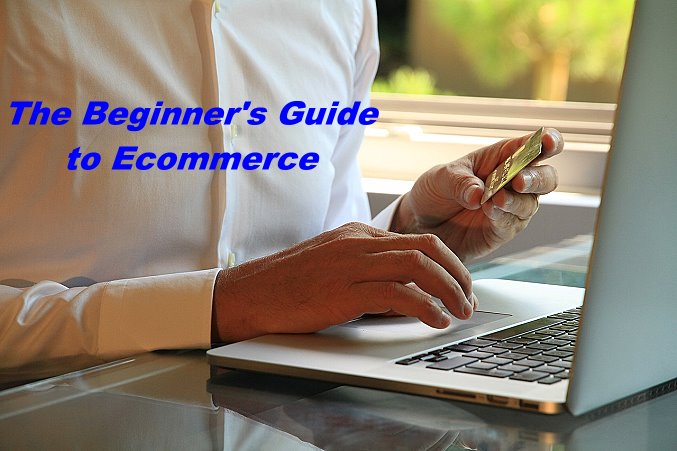
Ecommerce for Beginners
Ecommerce, AKA ‘e-retail’, accounts for 14.1% of all retail sales worldwide. Ecommerce is expected to increase 50% or more to 22% in 2023, according to Statista. Online sales are expected to grow 385% in a decade!
Facebook just released their State of Small Business Report which shows that COVID-19 has had a significant impact on retail sales, which is causing SMBs for alternate solutions. But here’s what’s most interesting:
The proportion of businesses making no sales through digital channels
fell from 35% to 13%
E-commerce sales are expected to rise roughly 50% and reach $6.5 trillion by 2023.
Online shopping has been growing, mainly as a matter of convenience, but with the pandemic, it became a way to avoid contact with others.
Some retailers had begun adding e-retail to their business strategy as a way to increase market share and profits. Now others are adding it to survive. As you can see, many retailers are turning to E-commerce.
Creators, such as artists, and smaller manufacturers have turned to ecommerce for the same reasons and as a way to build brand awareness.
 Ecommerce Statistics
Ecommerce Statistics
- Retail ecommerce sales totaled $4.13 TRILLION in 2020.
- Online shoppers purchase more often on a mobile device than desktop.
- Mobile is expected to be 73% of all ecommerce sales in 2021.
- Average shopping cart abandonment rate is about 68.8%
- 9% of those surveyed said they used voice technology to shop at least once a week.
- A DigitalCommerce360 survey showed 61% of participants don’t compare shops on other websites once they find a product they like.
- Free shipping was the most important factor for consumers when deciding which retailers to purchase from. (2/3 of online shoppers)
- Ease of shipping return was 2nd most important factor.
- 77% of interviewed participants said that they have ordered a purchase to a store for pickup.
- 68% of interviewed participants said that they check whether a product is available in a local brick-and-mortar shop.
Ecommerce Trivia
The first ecommerce transaction occurred in 1971 or 1972 when ARPANET, a pre-cursor to the Internet, was used to arrange the sale of marijuana between students of the Artificial Intelligence Laboratory at Stanford and students of the Massachusetts Institute of Technology. (Source: “What the Dormouse Said: How the Sixties Counterculture Shaped the Personal Computer Industry” by John Markoff.)
Which undoubtedly led to the first online review, “Far out, man.”
How to Start an Ecommerce Business
Keys to Success
- Finding a hungry market.
- Developing a solid business plan.
- Create using a customized and secure platform.
- Provide robust and responsive customer service.
We’re here to give you a clear strategy to grow your ecommerce business in 2021.
Ecommerce Business Classifications
You can sell B2B, B2C or both. C2B is also gaining traction online. C2B is where a consumer, such as an artist, sells goods to businesses – some kind of sole proprietor selling to larger businesses, whether wholesaling for resale or direct sales.
Types of Ecommerce Business Models
Business models and the technology to drive them depend on these questions. How will you manage inventory? How will you manage customer service? Who made the products?
There are a number of ways to start your own ecommerce business, but for this article, we will focus on two models.
1 Drop Shipping/Affiliate Marketing: With this model, you’re essentially setting up a storefront and letting suppliers handle fulfillment, support, refunds, etc. You earn a commission by promoting other people’s products. You might represent one merchant or several, or you might sign up with companies like Commission Junction or ShareASale, which are global affiliate marketing networks, specializing in pay-for-performance programs that drive results for businesses around the world.
Bloggers often use this model, writing articles or reviews, optimized for search engines, with a link to buy prominently displayed.
You could also market products using YouTube videos, Instagram or Pinterest. I know a guy who sells a ton of gadgets with reviews that he promotes on Twitter exclusively.
You avoid many of the problems, like having a garage full of inventory, but you might also have problems if your supplier is slow at shipping or the quality is less than expected.
Drop shipping or affiliate marketing is a model that works well for thousands of businesses.
2 Wholesaling: This model usually requires a capital investment in inventory, a system of tracking customer orders and shipping and securing the warehouse space itself. You are responsible for customer service and returns.
As with the first model, you can attract buyers around the world with search-optimized content on a blog or social media.
You can also capitalize on local brand recognition and build an ecommerce store or add one to your website. Examples would be gift shops, art dealers or small specialty food purveyors.
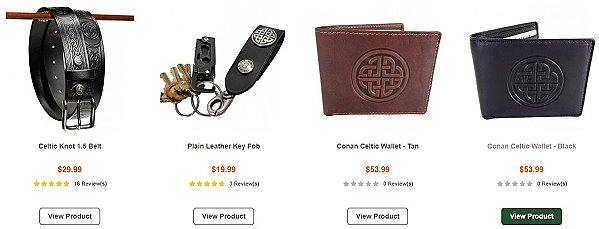
How to Start a Successful Online Store
Now that you’ve decided what business classification, products, it’s time to create a written business plan.
Jeff Bezos has had a little success in the online world, and he says, “If you don’t understand the details of your business, you are going to fail.”
Throughout the whole process, you’ll need to know your numbers, including sales, returns, marketing, platform and hosting fees. Marcus Lemonis from CNBC says, “If you don’t know your numbers, you don’t know your business.”
You will need to understand your costs, your market, your client avatars and sales potential. You will need to monitor all aspects of your sales funnel, including…
- Development Costs. What time and resources will be used to establish your online store? The platform, the setup and hosting.
- Product Descriptions. Who will write the descriptions of the merchandise? Descriptions and product photography are often provided by the merchants or networks, but you will need them, regardless.
- Customer Service. How will you handle support? Phone, chat/messenger and email are options, but who will be responsible?
- Marketing. Developing an audience, especially worldwide, by blogging is time-consuming, but can provide nonstop traffic for years to come. I know people who are making 5 figures a month with their blog, but it took them nearly a year to create 75 or 100 blog posts and reviews. Pay Per Click advertising is more immediate, if you know how to do it profitably.
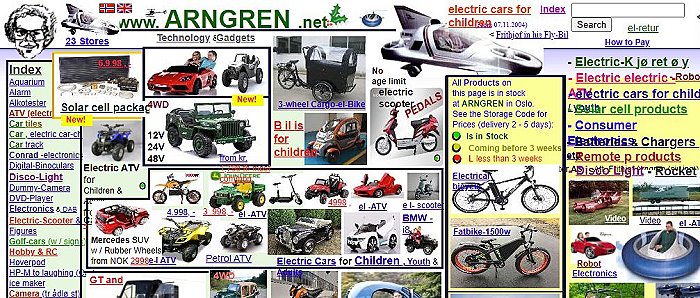
Ecommerce Examples
Example of Bad Ecommerce
 Arngren fails on so many levels, it’s a great example of bad ecommerce. It has product listings partially covering other listings, text on top of text, different sized graphics, you have to scroll to the right to see the whole page and more. The only good thing about the site is the index of categories on the left side.
Arngren fails on so many levels, it’s a great example of bad ecommerce. It has product listings partially covering other listings, text on top of text, different sized graphics, you have to scroll to the right to see the whole page and more. The only good thing about the site is the index of categories on the left side.
If you click on something that interests you, like the green Jeep, you come to a page that features DOZENS of electric cars, some are listed in columns with additional pictures and information, but I’m still not sure where the ‘Add To Cart’ button is. A confused mind doesn’t buy.
Examples of Good Ecommerce
Amazon is the most successful ecommerce in the world. There is a lot to be learned about e-retail. People will start their search with a broad term, such as “Irish wool sweater men, ” and a category page comes up with dozens of offerings.
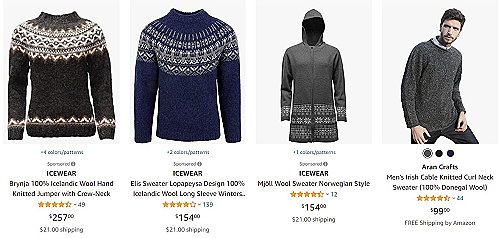
In this example, you see a picture of each item, information on how many patterns or colors it comes in, the name of the manufacturer, a brief description, a star rating and price and shipping information. The short description indicates that it’s made from 100% Donegal Wool.
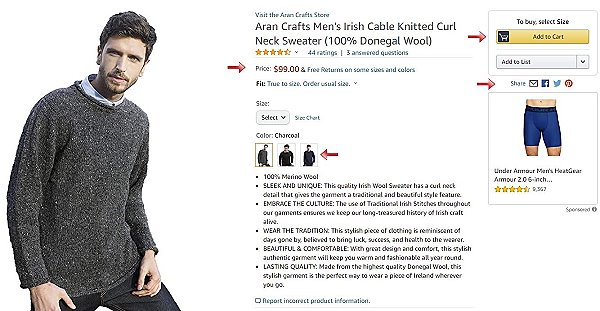
In this example of a good ecommerce product page, they’re showing a description, price, add to cart button, and 3 images. The other thing that I like is sharing buttons for email, Facebook, Twitter and Pinterest.
 Scroll down further and you’ll find large product description, that is more “About page” content than product description. They talk about the company being located in the county of Kildare and was established by Molly Cullen in 1957. Molly was the granddaughter of the first woman to market hand-knitted woolens. Molly’s sons took it over and now it’s the biggest knitwear manufacturer in Ireland. The description is 351 words!
Scroll down further and you’ll find large product description, that is more “About page” content than product description. They talk about the company being located in the county of Kildare and was established by Molly Cullen in 1957. Molly was the granddaughter of the first woman to market hand-knitted woolens. Molly’s sons took it over and now it’s the biggest knitwear manufacturer in Ireland. The description is 351 words!
That description adds value to the product and the story of the company is interesting.
They also have a nice section on how to care for the new garment. There is a section that reveals what the different stitches in the sweater mean.
Another section tells the buyer how to care for their new garment.
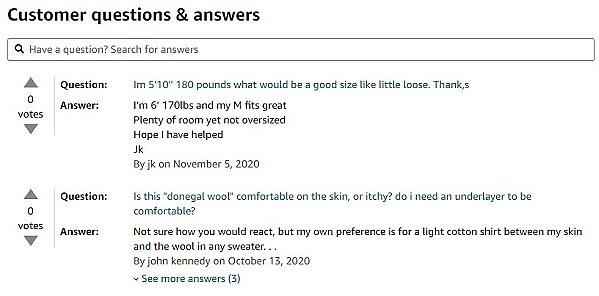
And finally, they have a section on Q&A that includes the questions asked by customers and the company’s answer. Example: “Is this ‘donegal wool’ comfortable on the skin, or itchy? Do I need an underlayer to be comfortable?”
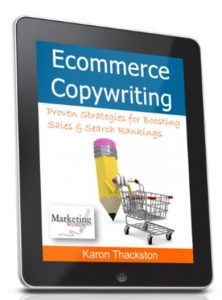
Get conversion techniques for greater profits
that turn ecomm product & category pages into landing pages!
Keys to Ecommerce Success
Help your visitors find what they’re looking for, but without confusing them. Simply listing “Related Searches” at the bottom of you page will keep them engaged and help lower your Bounce Rate.

Create Your Online Store With a Great Ecommerce User Experience

You will enjoy more success the easier you make it for your site’s visitors to find what they are looking for. Whatever page they land on should make it clear what the site sells and why buying from your site is better than going anywhere else.
On the Home page, which should serve as a Table of Contents, you should include strong Calls To Action, including popular sections of the site and product categories.
Shopify vs. WooCommerce
 You can sell anything online using Amazon, Magento, 1shoppingcart, Big Commerce, Oberlo, X-Cart and others. Two of the more common ways we see are using WooCommerce on a WordPress site or creating a Shopify store.
You can sell anything online using Amazon, Magento, 1shoppingcart, Big Commerce, Oberlo, X-Cart and others. Two of the more common ways we see are using WooCommerce on a WordPress site or creating a Shopify store.
WooCommerce vs Shopify is a showdown between two ecommerce giants. Shopify claims that it powers over 1 million online stores, while WooCommerce claims it’s the web’s most popular ecommerce platform and the plugin has been installed 5 million times. But which is right for you?
Shopify is powerful, reliable, and easy to use, offering lovely templates and brilliant customer support. With Shopify, you’re paying a monthly premium for a solid platform.
WooCommerce is the ecommerce plugin that turns any WordPress site into a powerful online store. It’s an open-source platform, and therefore free to install, making it ideal for cost-conscious users, but you’ll need to pay for things like hosting and security, however. If you’re already running a WordPress site, this may be your best choice.
Not only will WooCommerce allow you to showcase physical and digital goods, including product variations, it allows custom configurations, instant downloads, and affiliate items. Bookings, memberships, subscriptions, and dynamic pricing rules are only an extension away.
You can get paid in a variety of ways; accept cards, mobile wallets, bank transfers, and cash thanks to 100+ payment gateways – including Stripe, PayPal, and Square.
Taxes are calculated using the WooCommerce Tax plugin.
Shipping is easy. You can print USPS labels right from your dashboard. You can even schedule a pickup with WooCommerce Shipping (U.S.-only). Connect with well-known carriers such as UPS, FedEx, and ShipStation.
There are many other options, including email marketing integration with free and paid plugins. You can manage your store from anywhere using the mobile app. (Android and iOS) You might even like the “cha-ching” notification sound each time you make a new sale!
Shopify
 Shopify offers 70 or more themes to customize the look and feel of your store. It is completely customizable. There are free themes, but most of them are a $180 one-time cost.
Shopify offers 70 or more themes to customize the look and feel of your store. It is completely customizable. There are free themes, but most of them are a $180 one-time cost.
Shopify costs $29 to $79 to $299 per month, depending on features and the number of locations. All 3 plans allow you to accept payments at popup events, markets and local fairs, etc. You can add store management tools for an additional $89/mo.
Shipping calculations are only available with the Advanced Shopify option.
If you just want to add a buy button to an existing website, Shopify Lite costs $9/mo. In-person credit card processing rates start at 2.4% per transaction. They also have an enterprise plan for large businesses, Shopify Plus for $2,000/mo.
There are 4,000+ apps that integrate with Shopify.
Both WooCommerce and Shopify offer 24/7 support.
WooCommerce compared to Shopify. Which one is right for you? Share on XAttract Customers to Your Ecommerce Website
 Once you’ve built your shopping cart and stocked it with wonderful things, you’ll need to promote it. SEO is a great source of free, organic traffic and blog posts can sometimes attract and pre-frame customers for the sale.
Once you’ve built your shopping cart and stocked it with wonderful things, you’ll need to promote it. SEO is a great source of free, organic traffic and blog posts can sometimes attract and pre-frame customers for the sale.
Affiliate marketing can deliver immediate results, but the cost is often a 50% commission. Or you can become the merchant and sell through your own members.
Paid Ads on Facebook or the Google Content Network will also give you near-immediate results and as long as you don’t overpay, you might be profitable..
Google Shopping Ads show users a list of products that are related to their search, and when they click on a product they are redirected to the seller’s website.
If executed correctly, Google shopping ads can be a company’s largest source of lead generation. However, as these are ads that cost budget commitments, a substantial investment of time and research is needed before getting started.
When starting a paid advertising campaign, do not initiate with heavy investments but rather use small amounts to experiment with various targeted markets, and whichever experiment works, then proceed with investing larger amounts.
Serve your local market vs. selling nationally.
Reasons for Cart Abandonment
The Baymard Institute asked 4,560 respondents why they abandoned shopping carts. By far, the #1 reason was extra costs, including shipping costs and other fees.
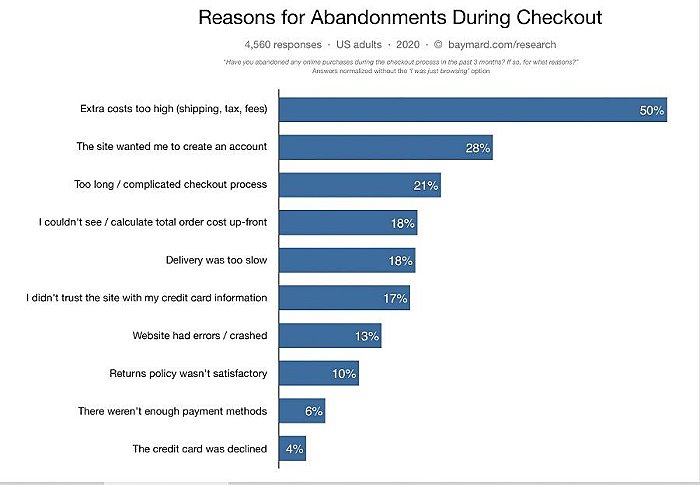
Online shoppers want easy. The second biggest reason they abandon shopping carts is the site required creating an account. #3 was due to the checkout process being too long and complicated.
Conclusion
So whether you’ve been forced to change your business model or you’re trying to develop a new income stream…
Ecommerce (e-Retail) is a new way for businesses to run their daily operations and it has changed dramatically since the beginning of the pandemic. Even when the pandemic disappears, it will continue to significantly impact the way business is done. So adapt to the new environment, because Ecommerce is the new normal.
Would you like to discuss your options? Schedule a 20-minute, no-obligation call today!

 Ecommerce Statistics
Ecommerce Statistics